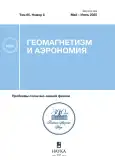The difference in the shape of the maxima of galactic cosmic rays (GCR) fluxes for positive (A > 0, even–odd cycle minima) and negative (A < 0, odd–even cycle minima) polarities of the solar dipole magnetic field is well known. For A > 0, a flat GCR maximum is observed, while for A < 0, a sharp one. This difference is associated with the influence of the drift mechanism of GCR propagation in the global magnetic field of the heliosphere, the proxy of which can be considered the polar (dipole) magnetic field of the Sun (Bpole). A homogeneous series of GCR data has been available since 1957, while Bpole observations have been conducted only since 1976. Using the example of odd (21st, 23rd and 25th) and even (22nd and 24th) cycles for which Bpole and GCR observations are available, we investigate the hypothesis that changes in the Bpole value and sign determine the main trends in the development of the entire modulation cycle. Traditionally, the beginning of the 11-year cycle in the long-term GCR modulation is associated with the minimum number of sunspots Rz, but the growth of Rz does not reflect all physical processes on the Sun capable of modulating GCR in the heliosphere. We select the maximum GCR intensity at 10 GV as the beginning of the modulation cycle (zero on the time scale) and then compare the count rate of the Moscow neutron monitor, the Bpole value, and the number of sunspots (Rz) using the superposition of epochs method. With such a choice of zero, the difference in the time profiles of GCRs in even and odd cycles is clearly visible. With a decrease in the Bpole module, the GCR fluxes decrease, the convective transport mechanism prevails, and the effect of drift transport is not visible (there is no clear division into even and odd cycles). With an increase in the Bpole module, the GCR fluxes grow, the diffusion mechanism of GCR transport prevails, which is helped or hindered by the drift mechanism (at A > 0 or at A < 0). The GCR fluxes remain constant at Bpole ~ const. The spot activity Rz is asymmetrical relative to the moment of polarity reversal (Bpole = 0), it is early in even and late in odd cycles. The discovered trends allow us to qualitatively predict the corridor of possible changes in Bpole and GCR fluxes in the decline phase of the 25th cycle and in the minimum of 25–26 cycles, as well as to make an epignostic forecast based on observations of GCR and Rz of possible Bpole values in 1957–1976 (the end of the 19th and the entire 20th cycle).
 307-313
307-313


 314-323
314-323


 324-334
324-334


 335-342
335-342


 343-350
343-350


 351-357
351-357


 358-369
358-369


 370-383
370-383


 384-395
384-395


 396-408
396-408


 409-416
409-416











